
Sacred Texts Hinduism Yoga Index Previous Next
Buy this Book at Amazon.com


Relax With Yoga, by Arthur Liebers, [1960], at sacred-texts.com
The first section of this book discussed the mental, or psychological, approach to Yoga. As you apply the earlier lessons to mental relaxation, you must also bring your body to a state in which it will support your efforts to attain full contentment, relaxation and ease. Ancient teachers of scientific Yoga realized, as do modern physicians, that proper carriage of the body is essential for mental and physical health. You will note that on the following pages there is very little reference to the Sanskrit philosophy of Yoga, for here we put aside the mind and devote our attention to the body. As you assume these postures, however, keep in mind the eight principles of Raja Yoga. They will help you in dealing with both mind and body as you practice Yoga.
At first, spend only as much time on each exercise as you can without feeling fatigued. As the timbre of your body improves and as your mind takes fuller control of your body, you will find it possible to remain in any pose for longer and longer periods. One of the most prevalent causes of sluggishness and disturbance of the digestive organs is faulty carriage of the body, especially above the waist, involving the spinal
and abdominal muscles. Practically all of us are victims of faulty posture and suffer from enteroptosis, a condition in which the stomach, intestines and very often the kidneys, liver and pelvic organs, are dragged downwards and remain permanently out of their correct anatomical positions.
Medical internists will verify the statement that poor carriage retards circulation of large blood vessels. An habitual slouching position causes the blood of the abdomen to stagnate in the liver, inducing a feeling of despondency and confusion, as well as headache, accompanied by coldness of the hands and feet, chronic fatigue and often constipation. The Yoga Institute in Bombay has traced varied disorders of the digestive and pelvic organs and even functional defects of the heart and lungs directly to poor posture habits. Persons who had been approaching invalidity as a result of posture habits are said to have been cured after a few weeks of training. Persons in normal health have gained markedly, physically and mentally, from a short, but regular, corrective posture program.
The proper pose of the body imparts graceful curves to the female figure and an air of strength to the male. The proper posture, as imparted by Yoga, embodies in beauty the feelings of triumph and self-respect, whatever the age or condition of the practitioner. The common drooped and slouching position is both ugly and unhealthy, and invariably reflects a degenerated mental attitude.
Ancient Yogis were perhaps first to recognize the influence of carriage on health of the mind and body. The prime objective of posture in Yoga is not mystic, mysterious or magic, but the achievement of physical ease and poise. An erect posture is recommended to maintain free spinal circulation during prolonged sitting and concentration.
When beginning the practice of Yoga postures, start with the simple prayer pose in a standing position. Medical investigation shows that many corrective and therapeutic benefits stem from even these first simple poses. It is no longer known whether the ancient Yogins, the founders of Yoga, attached any special mystical significance to these first poses. However, they are excellent poses for prayer and meditation.
This pose helps to achieve steadiness through gradual control of voluntary muscular movements and offers, through steadiness, the best physical attitude for standing prayer; it permits normal standing posture by coordinating skeletal muscles and it corrects postural defects.
While standing, hold your body as tall as possible without actually rising on your toes. Keep your heels together, placing all your weight upon the balls of your feet. Throw your head and chest up, shoulder blades flat. The abdominal muscles should be deflated at their lower part, but not drawn inward, and fuller just below the ribs, while the pelvis should be tilted at such an angle as to prevent any exaggeration of the lumbar curve. Your knees must be straight but not stiff, with legs together touching at the knees. Fold your hands over the sternum; avoid tension. Relax your mind and fix your eyes on any pleasing object before you.
In this position, the thorax is full and round; the diaphragm is high; the abdomen at its greatest length. The stomach and intestinal viscera are held in proper place and the pelvic organs are relieved of pressures from above. There is a partial relaxation of the larger muscles and relief from

Click to enlarge
Stitha-Prarthanasana, or Prayer Pose
tension. With the arms relaxed and let down at the sides, it is an ideal position for standing. Maintain this position for about one minute, breathing normally. Keep your mind free and observe complete silence. Turn slowly to either side, parallel to a wall or post, and notice whether you sway. Swaying is an indication of nervous disturbance which must be overcome.
If possible, practice opposite a mirror, where swaying motions can be noted. During the period of test and correction, keep your eyes half-closed, allowing just enough vision for observation, and concentrate on the parts of your body above the waist. Stand immobile as a statue, and as soon as you have a tendency to sway, check it by will power. After the first few weeks, try to sustain this motionless pose for two to three minutes, always breathing normally. This pose is best practiced in the morning, and should be followed daily until complete control has been achieved. Afterwards, it may be practiced once weekly.
Begin by assuming the Prayer Pose. Bend down, lift one leg with your hands and bring it up to the thigh. Keep your balance on the other leg. If you experience the fear of falling, stand and practice near a wall or window sill or other support. After you have attained sufficient steadiness on one leg, adjust the raised leg by pressing the heel tightly against the opposite groin, with the sole of the foot against the opposite thigh. Study the illustration (page 34) for details of this pose.
Steadiness, or nerve control and coordination between muscular and nervous systems, is one of the prime goals of Yoga physical education, and must be learned in slow stages. At first it may be necessary to use some support to maintain

Click to enlarge
Ekapadasana, or One-Leg Pose
balance. Later you will be able to practice without support, maintaining this pose with your hands in the prayer posture. It may be difficult to keep this pose for more than a few seconds at the beginning, but you should gradually be able to extend the duration of time until you can keep the pose comfortably for two or three minutes. Do not overdo at first. Limit practice to one or two minutes mornings and evenings, alternating legs.
In addition to exercising and relaxing the muscles and nerves of alternate legs, this pose helps to develop the nerve control necessary for relaxation. When swaying is experienced during this exercise, the best corrective is to concentrate your mind on each of your movements. Become consciously aware of the most insignificant variations in steadiness, so that you will be able to secure control over all motion. Along with other Yoga measures—meditation, diet, etc.—this posture facilitates nerve control in the course of a few months.
The traditional meditative posture, the Padmasana, or Lotus Pose, is essential for posture training, body-free meditation and preserving normal elasticity of the muscles connected with the pelvis and lower extremities. As noted previously, those who have been raised in the Western culture are stiff and lack flexibility in their legs and lower bodies. This must be corrected in order to restore natural suppleness of the limbs. The Lotus Pose may at first be a bit difficult, but with regular practice, massage of the limbs and determination, it can be achieved. Avoid undue strain and do not force yourself into this by violent jerks or tension of your legs. When you are ready for it, your body will fall naturally into the desired posture.
Now that you have begun the sitting and the lying-down exercises, you should avoid the use of a bare floor. If the room in which you are practicing is not carpeted, provide yourself with a soft mat at least 6 x 3 feet, and spread a clean sheet over the area where you will sit or lie.
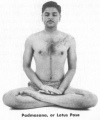
Click to enlarge
Padmasana, or Lotus Pose

Click to enlarge
Ardha-Padmasana, or Semi-Lotus Pose
Beginning with the Lotus Pose, sit on the floor with your legs stretched out. Bend the right leg slowly and fold it upon itself. Using your hands, place the right heel at the root of the thigh so that its sole is turned upwards and your foot is stretched over the left groin. Similarly, bend the left leg and fold it upon itself with your hands, placing the left heel over the root of the right thigh. Your ankles should cross each other, while your heel-ends touch closely. The left foot with its upturned sole should lie fully stretched over the right groin. Keep your knees pressed to the ground, feet tight against the thighs, and press your heels firmly against the upper front margin of the pubic bone slightly above the sex organs.
To complete this pose, hold your body erect, with neck straight, chest thrown forward and abdomen drawn moderately inwards. Fix your eyes on any object in front of you, then close them. Spread your left hand with its back touching both heels, palm upwards. Place your right hand over the left in the same manner. The ancient texts associate this pose with peace. Although many find it easier to achieve the pose by folding the left leg first, you may alternate the position of your legs.
A highly effective meditative posture, the Semi-Lotus Pose offers many corrective and cultural benefits. It results in either extension, flexion or relaxation to almost all the important muscles, ligaments and tendons of the lower limbs. It also induces increased blood circulation in the abdominal and genital areas by blocking the flow in some areas and drawing a larger supply of blood from the bifurcation of the abdominal aorta. Restraint of the general circulation
caused by the pressure of the heels provides an increased supply of blood to the sex organs and also helps to tone the various nerve centers located in the pelvic region, such as the chain of coccygeal and sacral nerves.
Respiration is improved as a result of the chest being thrown forward and the abdomen being held in normal position. Muscle tone is increased in the internal organs, especially those of the intestinal tract. In this posture, it is important that the shoulders should not sag forward, crowding the chest, nor should the upper part of the body crowd down upon the stomach and the abdominal viscera. The Lotus Pose is suggested for the regulation of breath movements.
This is a recent addition to the traditional asanas, or poses. Developed in the 19th century by Yoga practitioners, it is believed to increase the height of the user. While this benefit may be questioned, the pose induces a state of complete relaxation. An all-body stretch which does not strain even the novice in Yoga, this pose is most easily held while lying down.
To take this pose, harmonize your breathing with your actions. Lie on your back on a comfortable mat or carpet, with your legs and arms fully extended. Fall into a relaxed position. Inhale for three seconds and, while retaining your breath, stretch your body slowly to full length. Your toes and fingers should point outwards, as if trying to reach an object beyond their grasp. Repeat this stretch position for three seconds and then release the tension of the stretch

Click to enlarge
Yastikasana, or Stick Pose
while exhaling. Any maximum stretching of the body should be attempted only while the breath is retained. Do not attempt to hold your breath for more than four or five seconds.
To simplify the explanation of the Yastikasana movements: (1) With body supine, arms and legs outstretched, inhale for three seconds; (2) while your body is outstretched, hold your breath for three seconds; (3) return to the starting position; exhale for three seconds. Repeat the entire exercise five times in one minute.
The primary object of this posture is to stretch the body fully. It serves to correct faulty postural habits and tenses the usually relaxed abdominal and pelvic muscles.
According to the schools of Yoga which have utilized the Stick Pose, stretching aids height and its regular practice will at least halt the tendency of the aging to lose height. It may be done both in the morning and in the evening. Where it is used solely for relaxation, normal, rhythmic breathing should be maintained without any effort at stretching.
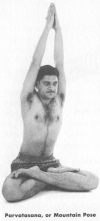
Click to enlarge
Parvatasana, or Mountain Pose
Overweight can bring both mental and physical problems. The posture known as Parvatasana, or the Mountain Pose, has been found in several Yoga institutes to be highly effective in maintaining slimness and in correcting minor postural defects of the spinal cord.
Assuming the Semi-Lotus Pose, slowly raise your hands upward and above the head. Keep your palms pressed together. If it is easier, interlace your fingers. Finally, stretch upward as if to touch some object directly above your head. Keep your arms close to your ears, your head erect, your back straight, and pull your abdomen in. While inhaling, raise the upper part of your body to its maximum height. Make sure your elbows and wrists are in a straight line.
Maintain this slightly stretched, upright position between breaths, since this is the point at which attempts at upward stretching are most successful. During this exercise, keep your eyes fixed on some object before you and keep your mind at ease. This pose was named Parvatasana because it has the appearance of a mountain.
For maximum benefits, the movements and breathing should be in harmony with actions as shown in the following instructions: (1) In a sitting pose, raise arms and inhale for three seconds; (2) maintain pose and try to retain breath for six seconds; (3) return to starting position, exhale for three seconds. Repeat this pose five times to a minute without pausing.
This posture tenses and pulls all the abdominal and pelvic muscles, strengthens and straightens the muscles of the back and also stretches and exercises the usually inactive waist zone. One of its most evident benefits will be the reduction of fat and flabby abdominal tissue. However, it must be followed consistently for one minute, both in the morning and evening.
There are four dynamic variations of this pose. They are: (1) Swaying forward; (2) leaning backward; (3) bending to the right; (4) bending to the left. These variations should be utilized during a six-second breathing pause. Instead of maintaining the perpendicular position while stretching, vary it by making the movements on the four sides and alternately. Gradually increase the retention of your breath to nine seconds, which will permit four movements to a minute. The purpose of the variations is to provide additional
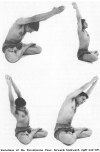
Click to enlarge
Variations of the Parvatasana Pose: forward, backward, right and left.
stretching of all sets of muscles in the trunk. They also massage the internal organs just below the ribs and the abdominal muscles.
The Trikonasana will enable you to reach a state of physical suppleness and elasticity that will have a relaxing effect on your mental state. It is more difficult at first than the earlier poses, as it calls upon ordinarily unexercised muscles. Because of the exceptionally straight and full-length adjustments of the bony structure of the spine, this pose will correct many of the ailments due to misplaced internal organs and poor body tonicity. The dynamic variations of this pose will enhance its benefits considerably.
Stand erect with your feet together and arms down at your sides. Slowly exhale while bending downward; keep your legs straight. Lower only the upper part of the body. Keep your legs perfectly straight and pressed backwards. Now, touch your toes with the tips of your fingers, keeping your arms straight, with spine and neck horizontal, abdomen in, head thrown forward, and your eyes fixed on the tip of your nose. Maintain this pose as illustrated on the next page, then return to the original position while inhaling. Your movements and timing should be as follows: (1) Touch toes and exhale for three seconds; (2) keep pose and hold breath for six seconds; (3) return to starting position and inhale for three seconds. Repeat five times in one minute without pausing.
Do not become discouraged if you fail to touch your toes on the first attempt. Try each day until you can hold the pose comfortably. Work into this pose gradually, avoiding attempts to force your body into it by jerks or sudden
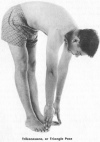
Click to enlarge
Trikonasana, or Triangle Pose
pulling of muscles. Before working for other refinements of the pose, aim to touch your toes. If you should find yourself feeling muscle tenderness, try a warm massage to alleviate the discomfort.
A dynamic variation of the Triangle Pose is fairly simple. Stand with your feet twenty-four inches apart and, while inhaling, raise one arm and bend it laterally on the opposite
side, sliding the other arm lengthwise. When the complete lateral stretch is achieved, retain your breath and return to the original position. Repeat the lateral stretch on the other side.
Movements, breathing and timing should be as follows: (1) Bend sideward; inhale for three seconds; (2) keep pose and retain breath for six seconds; (3) return to normal position and exhale for three seconds. Repeat alternately, without pausing, ten times in two minutes.
For best effects, the exercise should be practiced for at least one minute. However, persons with poor physical tone and those with a history of circulatory or respiratory ailments should try it only in moderation, for about ten seconds at one time.

Click to enlarge
Variations of the Triangle Pose
Another cause of both physical and mental tenseness is a lack of suppleness and elasticity in joints and extremities. Correctives for this are postures involving fairly simple body twists. The purposeful twisting of the extremities may be accomplished through the Garudasana.
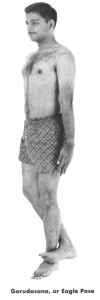
Click to enlarge
Garudasana, or Eagle Pose
Stand erect as shown in the illustration. Lift either leg (the alternate use of each leg will follow), and twist the same leg both near the hip joint and the knee. Then twine one leg around the other. Adjust the twists very carefully without strain or muscle tension. Lock the ankle with the toe of the other twisted leg and hold it there as a safety against possible accidental release. Do this while exhaling. When you are balanced on one leg, make an effort to keep the body straight, and gradually increase the pressure of the toe-hold near the opposite ankle until the greatest possible twist is achieved.
At first, practice only the leg twist while retaining your breath. After the first week or so, when this becomes easier, try the arm and hand twists by twining one arm around the other (alternating arms). Twist the hands from the wrists and press the palms against each other. Try to keep
the pose for several seconds and, while inhaling, return to the original position.
Do not force yourself into this pose until your limbs have gained sufficient suppleness. Then you should follow this time-plan: (1) Twist your body and exhale for five seconds; (2) maintain the pose as shown in the illustration and retain your breath for ten seconds (or you may with normal, rhythmic breathing hold the pose for not more than two minutes); (3) return to starting position and inhale for five seconds.
It is advised that this posture be repeated alternately three times on each side for a two-minute period, preferably in the morning. Note that in the Garudasana you should avoid straining while twisting. Practice it by gradual stages before attempting to follow the full exercise.